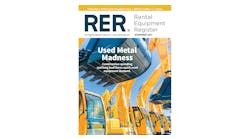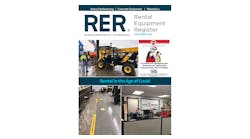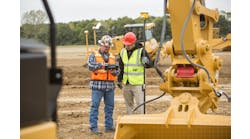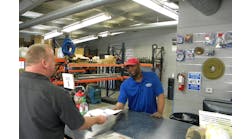Of all the tools sitting on the rental showroom floor, the long-reach air tool may be one of the most under-appreciated and under-utilized. Despite having been on the market for more than four decades — and touted by many contractors for its value — the tool's potential often is not maximized by rental centers, and it is commonly relegated to collecting dust in a corner.
Because of their functionality, long-reach air tools fit the job requirements of a wide group of homeowner and contractor customers. They are ideal for removing vinyl and ceramic tiles, carpet adhesives and material buildup from floors and walls. The small size and high-power output of these tools make them useful for chipping away concrete and asphalt or removing slag and scale materials on industrial and marine jobsites. This equipment can also be used for overhead projects including asbestos and acoustic tile removal.
Despite the tools' wide-ranging capabilities, they are often difficult to sell or rent because they are misunderstood. Although an effective solution when a customer has limited resources and a relatively small job, they are many times eliminated from suggestion because a rental professional doesn't completely understand the customer's needs or how the tool can help address them.
Selecting the proper machine and process involves experience, skill and practical sense, but knowledge of these tools can help a rental company make a solid return on investment.
AIR TOOL EDUCATION
Consider this situation: A customer walks into the rental center looking for a solution to a surface removal problem. Perhaps it's removing stuck floor tiles in a hard-to-reach area of a bathroom or kitchen. Maybe it's a contractor trying to peel material off a wall. Either way, the customer needs the right equipment to get the job done quickly and effectively. While the customer understands the end goal, he or she is not quite sure of the best way to get there.
This situation is not uncommon; therefore, it's crucial that a rental center employee is educated on the proper use and benefits of long-reach air tools. It's imperative to understand how they work and how to properly power them. Ask yourself: What equipment should I give to my customer? How should I outfit this tool? If this information isn't known, contact the manufacturer or sales representative for technical assistance.
Unless the person behind the counter has experience with surface preparation, the customer probably isn't going to be as successful with this equipment as they should be. It's the job of the rental center operator to maximize marketing opportunities. Ideally, every time a customer walks through the front door, the rental professional should have a solution for that customer's problem.
Once it's determined that these tools are the best fit for a customer's job, other concerns must be addressed. The customer needs a power source for the tool, such as an air compressor, and a way to transport it to the jobsite. Make sure these basic needs are taken into account before sending a customer out the door.
PRESSURE AND FLOW
The informed customer should know the basic premise that long-reach air tools operate on compressed air. Therefore, it is vital to power the tool with an appropriately sized compressor. Long-reach air tools always tax a small air compressor, so it's important to identify the pressure and airflow needed to meet the tool's demands. Most of these tools operate best at 90 psi. Required flow rates can vary from 5 to 15 cubic feet per minute. These performance values can usually be met by most common 5-hp and higher gasoline-powered compressors. But remember, if unsure whether the compressor is adequate, contact its manufacturer for assistance.
It's also critical that the compressor is in proper operating condition. An older, well-used compressor may not be able to produce the air pressure and flow it's rated for or be able to maintain this performance throughout the job. Ensure the rented compressor is functioning properly so the customer's project can be completed efficiently.
Of course, a properly sized and efficient air compressor won't help much without having a way to deliver the compressed air to the tool. At this point, the rental professional will know what diameter and length of air hose to recommend. After all, utilizing a ¼-inch hose on a job requiring at least a 3/8-inch hose will restrict the amount of air going to the tool, choking it of its necessary air supply and inhibiting it from operating properly. The same rule applies for the quick couplers, so make sure they match the hose size for maximum efficiency.
Too much hose length will also negatively affect the performance of the tool. Poiseuille's Law, which relates friction to increasing hose length, tells us that the friction of a longer hose will reduce the air pressure over its length. This means that even with a correct hose and coupler diameter, the tool may still not be getting the correct and steady amount of air.
A common situation where too much hose length is used on a jobsite occurs when a compressor is powered by a generator. Usually the generator is placed far from the actual work area to reduce noise and emissions concerns. However, locating the compressor too far away requires a longer length of hose and increases the effects of Poiseuille's Law. If adequate ventilation is available and ear protection is used, consider placing the generator and compressor closer to the project to ensure the tool receives the necessary amount of air to work properly.
Remember, the amount of air pressure determines the blow force or how hard the tool hits the surface. The flow rate determines frequency or how fast the tool hits. The tool may be hitting at a good frequency, but if it doesn't have the air pressure behind it, the job isn't getting done as effectively as possible. The same can be said if pressure is sufficient, but the flow rate is restricted.
THE RIGHT ATTACHMENTS
Having the right compressor, hose and couplers is important. It's also vital to provide the proper attachments so the customer has the correct tools to get the job done. With long-reach air tools, it isn't always a “one-size-fits-all” mentality. Find out exactly what the customer needs.
For example, if removing ceramic tile, how is the tile bonded? What type of adhesive was used? What is the backing layer the tile is adhered to? Don't be afraid to ask questions. The more one knows about what the customer is trying to accomplish, the easier it will be to determine the necessary attachments.
Long-reach air tools have a wide variety of attachments from which to choose. In some cases it may be ideal to offer a kit containing many attachments. In the above example, it's likely a 4-inch-wide chisel might not be the best tool for the entire job. Maybe it will take a 2-inch chisel to get the right results. The customer may need to work with the attachments until they find one that really works.
PROPER MAINTENANCE
With all equipment, the key to longevity and maximum performance is maintenance. It's no different with long-reach air tools. Practicing routine maintenance will keep them in top form.
Maintenance is often ruled by common sense. It's important to keep the tool's internal mechanism lubricated so retained moisture doesn't cause corrosion. As part of a regular maintenance schedule, it may be necessary to run lightweight oil through the tool to clean it out. This ensures it hits properly and at the right frequency. Additionally, special air tool lubrication oil is readily available.
If the tool isn't rented out on a regular basis, it's wise to take it out and run it periodically. This loosens up old oil deposits and corrosion, which may interfere with the piston's movement and affect blow force and frequency. This practice also ensures the tool is always in proper operating condition and ready for the next customer.
Since these machines aren't particularly complex, performing routine maintenance can be both quick and easy. Taking a few steps to ensure the equipment functions properly will save rental professionals from repair headaches down the road.
DON'T FIGHT THE MACHINE
The beauty of employing a piece of equipment to tackle a task is that less manual labor is required for the operator. However, this benefit can sometimes be forgotten if the customer insists on using muscle instead of letting the machine do the work. Before customers walk out of the store, remind them to allow the tool to do its job. Don't fight it! Not only is this a more efficient way to complete the task at hand, but it also guards against damaging the tool and reduces the risk of operator injury.
Rental center operators should also avoid fighting the potential these tools can bring to their business. When savvy professionals increase their understanding of the product and follow a few tips, long-reach air tools can help do the work to grow business. This equipment's wide variety of applications offers exceptional versatility for customers. By taking advantage of the tool's benefits, rental centers can see big returns — in both customers and return on investment.
Dennis Von Ruden is the president of General Equipment Co., based in Owatonna, Minn.





